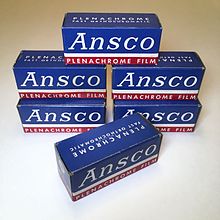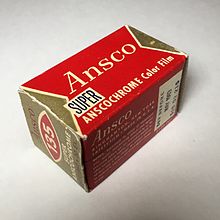
Film stock is an analog medium that is used for recording motion pictures or animation. It is recorded on by a movie camera, developed, edited, and projected onto a screen using a movie projector. It is a strip or sheet of transparent plastic film base coated on one side with a gelatin emulsion containing microscopically small light-sensitive silver halide crystals. The sizes and other characteristics of the crystals determine the sensitivity, contrast and resolution of the film. The emulsion will gradually darken if left exposed to light, but the process is too slow and incomplete to be of any practical use. Instead, a very short exposure to the image formed by a camera lens is used to produce only a very slight chemical change, proportional to the amount of light absorbed by each crystal. This creates an invisible latent image in the emulsion, which can be chemically developed into a visible photograph. In addition to visible light, all films are sensitive to X-rays and high-energy particles. Most are at least slightly sensitive to invisible ultraviolet (UV) light. Some special-purpose films are sensitive into the infrared (IR) region of the spectrum.
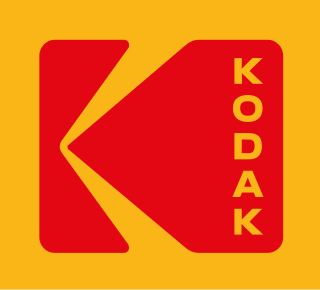
The Eastman Kodak Company is an American public company that produces various products related to its historic basis in analogue photography. The company is headquartered in Rochester, New York, and is incorporated in New Jersey. It is best known for photographic film products, which it brought to a mass market for the first time.

George Eastman was an American entrepreneur who founded the Eastman Kodak Company and helped to bring the photographic use of roll film into the mainstream. After a decade of experiments in photography, he patented and sold a roll film camera, making amateur photography accessible to the general public for the first time. Working as the treasurer and later president of Kodak, he oversaw the expansion of the company and the film industry.
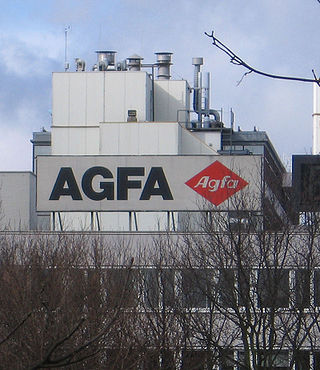
Agfa-Gevaert N.V. (Agfa) is a Belgian-German multinational corporation that develops, manufactures, and distributes analogue and digital imaging products, software, and systems.

ORWO is a registered trademark of the company ORWO Net GmbH, based in Wolfen and is also traditionally known for black and white film products, made in Germany and sold under the flag of the ORWO brand.

Kodachrome is the brand name for a color reversal film introduced by Eastman Kodak in 1935. It was one of the first successful color materials and was used for both cinematography and still photography. For many years, Kodachrome was widely used for professional color photography, especially for images intended for publication in print media.

In photography, reversal film or slide film is a type of photographic film that produces a positive image on a transparent base. Instead of negatives and prints, reversal film is processed to produce transparencies or diapositives. Reversal film is produced in various sizes, from 35 mm to roll film to 8×10 inch sheet film.
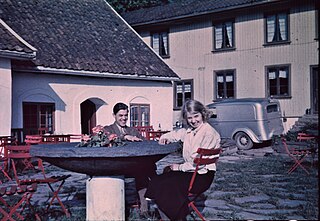
Agfacolor was the name of a series of color film products made by Agfa of Germany. The first Agfacolor, introduced in 1932, was a film-based version of their Agfa-Farbenplatte, a "screen plate" product similar to the French Autochrome. In late 1936, Agfa introduced Agfacolor Neu, a pioneering color film of the general type still in use today. The new Agfacolor was originally a reversal film used for making "slides", home movies and short documentaries. By 1939, it had also been adapted into a negative film and a print film for use by the German motion picture industry. After World War II, the Agfacolor brand was applied to several varieties of color negative film for still photography, in which the negatives were used to make color prints on paper. The reversal film was then marketed as Agfachrome. These films use Color Developing Agent 1 in their color developer.
The American IG Chemical Corporation, or American IG for short, was an American holding company incorporated under the Delaware General Corporation Law in April 1929 and headquartered in New York City. It had stakes in General Aniline Works (GAW), Agfa-Ansco Corporation, and Winthrop Chemical Company, among others, and was engaged in manufacture and sale of pharmaceuticals, photographic products, light weight metals, synthetic gasoline, synthetic rubber, dyes, fertilizers, and insecticides. The Moody's industrial manual listed an affiliation between IG Farben and American IG at the time of founding. First, Hermann Schmitz, who was the second after Carl Bosch in IG Farben's hierarchy, and then his brother, Dietrich A. Schmitz, served as American IG's presidents. It was re-incorporated as General Aniline & Film (GAF) Corp. in 1939 after a merger with General Aniline Works.
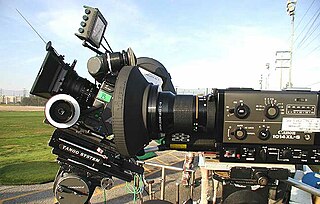
A Super 8mm camera is a motion picture camera specifically manufactured to use the Super 8mm motion picture format. Super 8mm film cameras were first manufactured in 1965 by Kodak for their newly introduced amateur film format, which replaced the Standard 8 mm film format. Manufacture continued until the rise in popularity of video cameras in the mid-1970s. In 2014 the first new Super 8mm camera in 30 years was introduced by the Danish company Logmar Camera Solutions. Most other cameras readily available are from the 1960s through the 1980s.
A chromogenic print, also known as a C-print or C-type print, a silver halide print, or a dye coupler print, is a photographic print made from a color negative, transparency or digital image, and developed using a chromogenic process. They are composed of three layers of gelatin, each containing an emulsion of silver halide, which is used as a light-sensitive material, and a different dye coupler of subtractive color which together, when developed, form a full-color image.
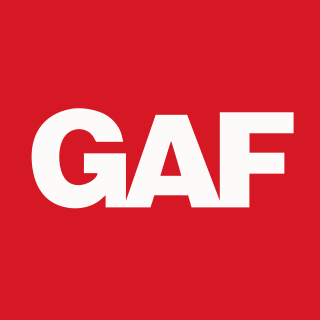
GAF is an American manufacturing company based in Parsippany, New Jersey, that has roots dating back to the late 19th century. The GAF acronym stands for General Aniline & Film. The company has historically been primarily focused on manufacturing of roofing materials for residential and commercial applications. At one time GAF was also active in manufacturing photographic film as well as cameras and projectors, and was the manufacturer of the View-Master, the famous line of 3D transparencies, viewers and projectors. Briefly in the 1970s, it was the official film of Disneyland and Walt Disney World, and at this time actor Henry Fonda served as the company's spokesman in several television commercials, including one that featured Jodie Foster in her first acting role. John Altmeyer is the CEO of GAF, an operating subsidiary of Standard Industries.

E. & H. T. Anthony & Company was the largest supplier and distributors of photographic supplies in the United States during the 19th century.
Ansco Company Charles Street Factory Buildings, also known as Agfa-Ansco, General Aniline and Film (GAF), and Anitec, is a historic factory complex located at Binghamton, Broome County, New York. They are two early factory buildings built in 1910–1911, and a warehouse built in 1953–1954. The larger building measures approximately 45 feet wide and 230 feet long. It is a three-story, rectangular brick heavy timber frame building. The powerhouse is a two-story, reinforced concrete and steel brick building measuring 60 feet square. The buildings housed manufacturing operations of Ansco for photographic paper.

General Cigar Company–Ansco Camera Factory Building, also known as Agfa-Ansco, General Aniline and Film (GAF), and Anitec, is a historic factory complex located at Binghamton, Broome County, New York. It was originally built in 1927-1928 for the General Cigar Company; Ansco purchased the factory in 1937. The factory building is a four-story brick building with basement, five bays wide and 20 bays long. It has an intersecting four-story wing and two-story addition constructed in 1950. The building measures approximately 62 feet wide and 402 feet long. The powerhouse is a one-story, steel frame and brick building measuring 36 feet wide and 52 feet long. The buildings housed manufacturing operations of Ansco for cameras and photographic equipment. The factory closed in 1977.
Sawyer's, Inc. was an American manufacturer and retailer of slide projectors, scenic slides, View-Master reels and viewers, postcards, and related products, based in Portland, Oregon. Founded in 1914 as a photo-finishing company, Sawyer's began producing and selling View-Masters in 1939, and that soon became its primary product. It later diversified into other photographic products, mostly related to film transparencies, and established manufacturing plants in Europe, Japan and India. By the early 1960s, Sawyer's was the nation's second-largest manufacturer of slide projectors, and by 1965 slide projectors had surpassed View-Master reels and equipment as a percentage of the company's annual sales. In 1951, the company moved from Portland proper to the unincorporated Progress area in Portland's southwestern suburbs. In 1966, Sawyer's was acquired by New York-based General Aniline & Film (GAF), and its product lines and facilities were taken over by GAF. It was a subsidiary company of GAF until 1968, when it became simply a division of that company, renamed the GAF Consumer Photo Division. For several years thereafter, GAF used "Sawyer's" as a brand name for its slide projectors.
Lloyd E. Varden was an expert in the photographic field and related sciences. He was an adjunct Professor of Photographic Sciences and Engineering at Columbia University in New York 1951-1968.


